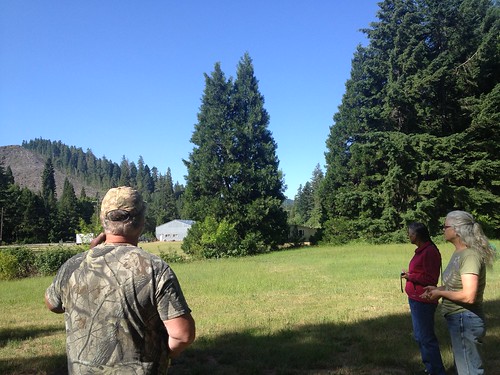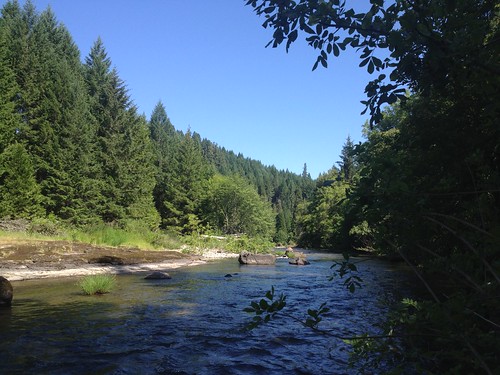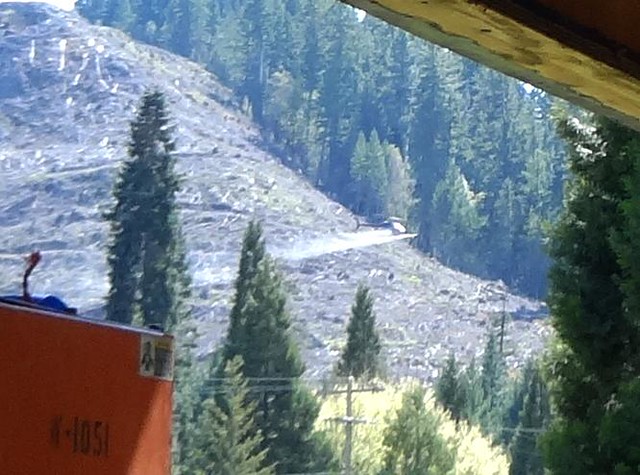
The view from a clearcut on Seneca Jones timber land, the subject of a pesticide spray investigation, with the community of Tiller, Oregon, below.
Oregon Department of Agriculture
TILLER, Ore. -- The laws meant to prevent pesticides drifting across Oregon forests don’t always work.
Lori Valuch knows it. Her husband Joe knows it. And so do their neighbors, whose properties tested positive for stray weed killer last April after Valuch complained to the state Department of Agriculture.
"I realize they need to do spraying to control things on their land for the growth of their trees. But at the same time, I don’t want to be poisoned by it," Valuch said.
Complaints and theories about helicopters spraying chemicals are nothing new in Tiller. The same is true in Oregon communities like Triangle Lake, Rockaway Beach, Gold Beach and many other towns dotting the forested coast and its mountain range.
Those pesticides are meant to kill vegetation that would compete with the next crop of tree seedlings. But residents worry about what the chemicals are doing to their air and water.
They might soon see some changes. After a spray gone wrong last year near Gold Beach on the southern coast, state legislators are drafting changes to the laws for aerial spraying on Oregon forests. A judge in Curry County is weighing a legal challenge to the state's Right to Farm and Forest Act, which shields farm and timber operations from nuisance or trespass lawsuits.
State officials and lobbyists for Oregon’s $5 billion timber industry have defended Oregon's existing laws and framed the Gold Beach conflict as the fault of one bad pilot.
The state called him "uncooperative" and said he defied common sense for flying directly over homes. Officials fined him the maximum $20,000 and revoked his license because "gross negligence" and "willful misconduct." Industry groups called the pilot's actions "extreme cases of negligence."
Lori Valuch doesn't know it, but her complaint might be a stronger indictment of Oregon's protections against forest pesticide drift than the widely reported Gold Beach case. It's an example of how sometimes communities report drift even when timber companies appear to be following the rules.
In Tiller, there's no sign of a problem pilot like the one at the center of the Gold Beach case. The Tiller case's helicopter pilot cooperated with state investigators and called the application "routine." Investigators called it "appropriate." A forester stayed on-site and made sure precautions were taken beyond the legal requirements.
Chemicals still drifted. Neighbors still claimed they were poisoned. And the pilot will likely face fines because of it.
“Sometimes people can be following all the laws carefully, but if the laws aren’t protective enough for public health, then public health is still going to be harmed,” said Rep. Ann Lininger, D-Lake Oswego, one of the lawmakers working on new aerial spraying legislation.
Jackson Creek, protected waterway?
Joe Valuch, Chris Rusch and Lori Valuch (far right), stand in the Valuches yard and look toward the bare hillside owned, logged and sprayed by the Seneca Jones Timber Company. Credit: Tony Schick.
Joe Valuch can see the bare hillside from his front yard. Staring at it stirs the anger in him, months after the fact. On April 16, a helicopter sprayed the Seneca Jones Timber Company property with chemicals later found hundreds of feet off site.
“Yeah, it ain’t like we’re a bunch of tree huggers or nothing, but that’s a little out of control. I mean it’s … it ain’t right,” said Valuch, a semi-retired mold maker. “I’d go to these guys’ house and start spraying a bunch of stuff and see how they like it.”
It did not make a difference to Valuch that state sampling later showed no trace of herbicides on his property. He knows they were sprayed. His wife, Lori, kept a log of their health symptoms, including burning eyes and throat. Their symptoms were similar to those reported by a handful of others in the area who said they became ill the night after the spraying.
Where it happened
Besides, Valuch’s short-term symptoms are not his main concern. He’s worried about Jackson Creek. It feeds into the South Umpqua River just down the road from their property. Shaded and stony, it’s prime habitat for threatened salmon and steelhead.
On a bright day in June, the Valuches and neighbor Chris Rusch, a retired Forest Service botanist, made the drive and walked its banks on the hunt for herbicide damage.
It was here state samples detected trace amounts of the weed killer atrazine, one of the chemicals sprayed on the Seneca Jones land just across the creek.
Rusch spotted damage left, right and center.
“Look at that tree right there that’s kind of defoliated,” she called out, stepping toward the water for a better view. “That one right in front of us there, see that Oregon ash tree foliage ... gone, pretty much.”
Lori followed, but Joe lingered behind, staring at the water from a grassy bank and thinking instead of the fish he's not allowed to catch here.
"Nope,” he said. “It's all protected. Spawning grounds. Protected from people who would catch and release. Not from people who would dump and destroy."
Does a bigger buffer make a difference?
Jackson Creek is protected spawning grounds for salmon and steelhead. The weed killer atrazine, harmful to fish, was recently found to have drifted across it, according to state investigators. Photo by Tony Schick.
Atrazine is sprayed after clearcutting and before young Douglas fir trees are planted. The pesticide kills vegetation that would otherwise grow where foresters plant their next crop of young trees. Atrazine doesn't just kill alder and blackberry vines. Studies show it’s also harmful to fish and amphibians.
“There’s a huge amount of data on salmon showing that atrazine interferes with their ability to make sperm, it interferes with the male’s ability to follow the female’s pheromones and find the females, it interferes with some of the gill function at levels similar to what we’ve seen in frogs," says Tyrone Hayes, a professor at the University of California at Berkeley.
Hayes has been in a fight with atrazine's manufacturer, Syngenta, since his research showed low doses of the chemical affected frog hormones. He recently spoke at the University of Oregon and met with concerned citizens at an event organized by the advocacy group Beyond Toxics.
One case of drift won’t cause lasting harm, says Hayes, who studies long-term exposure. But if Oregon can't keep such chemicals out of drinking water and habitats like Jackson Creek, he sees that as a bigger problem.
The pesticides used by timber companies make up a small percentage of what's used in conventional agriculture. But aerial spraying on Oregon forests has been controversial for decades. The practice was stopped on federal forests in the 1980s and environmental lawsuits have forced restrictions on where certain pesticides can be used near water.
For years, environmental groups have pointed out Oregon offers less protection from drifting chemicals than other states. Oregon has a required 60 feet buffer where spraying is prohibited around fish-bearing streams. Oregon requires no such buffer around homes. Neighboring states require buffers of up to several hundred feet. Idaho has a rule that prohibits spraying within a half mile of cities and suburbs.
“The kind of distance that I think we’re talking about, when this stuff seeps into groundwater, when this stuff travels down streams, when we know it can travel in the air for 1,000 kilometers, a 60-foot-buffer or 100-foot buffer I don’t think makes that much difference,” Hayes said. “It’ll still leach into the water.”
In Tiller, atrazine drifted about 250 feet past its target. One complaint came from 1,000 feet farther. Even the stricter rules advocates prefer wouldn’t require buffers that large.
The U.S. Environmental Protection Agency and the National Oceanic and Atmospheric Administration have also cited Oregon's lack of measures to "ensure adequate stream buffers for the application of herbicides."
The Oregon Department of Forestry maintains that the current buffer requirements adequately protect fish and water quality. It cites an agency study from 2000 that assessed their effectiveness.
The pesticide drift in Tiller has not prompted further scrutiny of the existing buffers, according to Marganne Allen, manager of Field Support, Policy and Monitoring for the department.
“We feel we have strong information to indicate that those are effective in meeting our desired goals for protection of natural resources and aquatic life,” Allen said.
An 'appropriate' application, but questions linger
Joe Valuch took this photograph of the Applebee Aviation helicopter spraying near his home in Tiller, Ore., in April.
When Lori Valuch called Seneca Jones to complain that afternoon in April, she was surprised to be told the conditions were ideal for spraying. Now, after keeping its investigation open for seven months, the Oregon Department of Agriculture has little evidence showing otherwise.
Seneca Jones hired Applebee Aviation to conduct the spraying. The state’s case file shows investigators ruled out other sources for the atrazine found and cited Applebee and pilot Patrick Hall each with two counts of violating Oregon law for allowing it to drift off target and over water. Hall and Applebee Aviation did not respond to interview requests. According to state documents, they described the application to investigators as routine.
The state’s case file also shows the companies appear to have followed the rules meant to prevent drift.
A Seneca Jones forester was on site monitoring conditions. Reported wind speeds were within the desired range. Spraying stopped when winds picked up. They left a 160-foot buffer -- larger than the state required. An investigator's notes describe the spray method as "appropriate."
Seneca Jones forester Ted Reiss said he’s as curious as anyone about what went wrong.
“The application, we believe, was done correctly and still had a result where a very small amount was found where it shouldn’t have been,” Reiss said. “And that’s interesting to us as well.”
The Oregon Department of Agriculture has not finalized its investigation. Pesticide program manager Dale Mitchell said it was too soon to tell if the case could prompt future changes in practice.
Stu Turner has spent decades as an independent investigator of agricultural damage in the Northwest. He has represented farmers, timber companies and the people who complain about them in drift cases. He said this wouldn’t be the first time a company did most things right and still faced a violation. The Northwest’s steep hillsides and the proximity of homes and fragile ecosystems to private forestland often create a no-win situation for his clients.
"The label says 'thou shall not drift,' period," he said. "This is somewhat unrealistic in the real world."
Turner reviewed the state’s case file on Tiller at the request of EarthFix. He spotted some areas the pilot might have done better -- using a better spray nozzle for larger droplets that don't drift in the wind -- but he found nothing definitive.
“There is no flashing neon arrow saying 'this is what went wrong.' But what it does tell you is whatever they’re doing in the current program is not adequate,” Turner said.
Some in timber industry see potential for improvement
Beyond Toxics Executive Director Lisa Arkin, left, and state representative Ann Lininger, D-Lake Oswego, listen to a pesticide applicator at a workshop in Triangle Lake. Photo by Tony Schick.
It was late October when Beyond Toxics rallied citizens from across Oregon to a workshop in Triangle Lake, a community northwest of Eugene with a history of pesticide complaints. Lisa Arkin, the director of Beyond Toxics, has been one of the state’s most vocal opponents of aerial pesticide spraying, and the workshop -- the same one Hayes attended -- furthered the momentum she gained after the Gold Beach case.
Stories about spraying gone wrong were exchanged. Concern met more concern about what it all means for health and the environment.
The crowd cheered when Rep. Ann Lininger, a Lake Oswego Democrat and the only lawmaker in attendance, took the microphone and announced a cadre of legislators had been working on a bill for the coming session. Goals include better notification about what’s being sprayed and when, as well as wider buffers for homes, schools and streams.
Efforts to change the rules began in the state Senate Environment and Natural Resources Committee, which held hearings in the aftermath of Gold Beach. The next is in December. In the meantime, committee chair Michael Dembrow, D-Portland, has scheduled meetings with members of the timber industry.
For some in the industry, revising Oregon’s forest practices seems a nonstarter.
Timber industry lobbyist Scott Dahlman said groups like Beyond Toxics have “tried to paint this picture of just rampant, indiscriminate pesticide use,” and that forest activities are already widely regulated.
Others are more receptive.
H.V. Allen has worked both as a Christmas tree farmer and for a helicopter company. He’s also had a front-row seat to watch the pesticide controversy play out around Triangle Lake.
At the workshop there, Allen said Oregon’s forestry and agriculture departments should have more authority to stop spraying when it has the potential to become problematic.
“We have to legislate them more authority so that they can more readily give citations, stop spraying programs that are going bad and things like that. Instead of saying ‘Oh, well, now we have to have an investigation,’” Allen said.
Ted Reiss, the Seneca Jones forester who wonders what went wrong in Tiller, also doesn’t begrudge scrutiny of aerial spraying.
“I don’t know that the industry is being unfairly vilified,” he said. “I think there are relevant questions associated with making sure that things are done right and people’s health and the environment is protected.”




